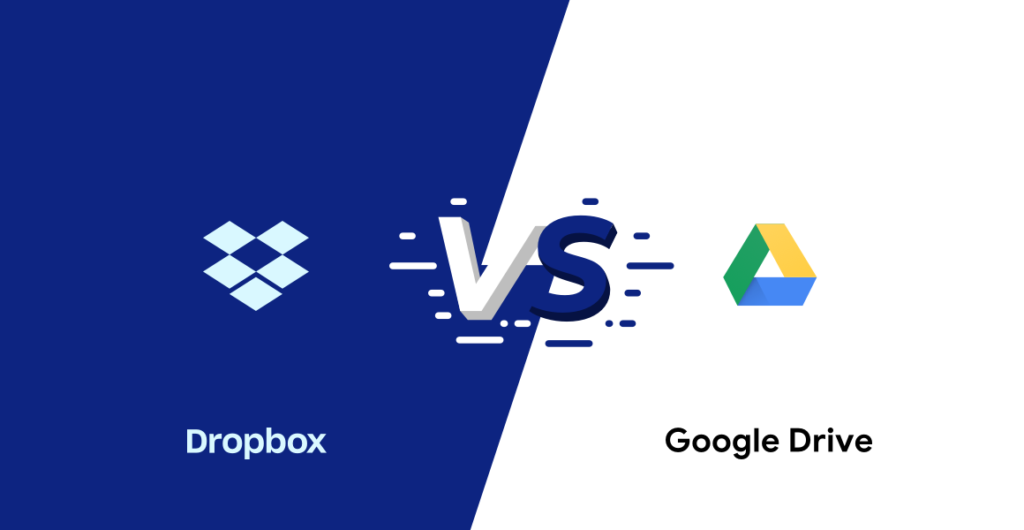Dropbox vs. Google Drive remains one of the most debated comparisons for individuals and businesses alike in the ever-evolving world of cloud storage. These two industry giants have become household names, each carving its niche by providing reliable storage solutions, seamless file sharing, and advanced integrations. However, understanding which platform truly stands out requires a closer look at their unique strengths and weaknesses.
Dropbox vs. Google Drive is not just a matter of preference but one of functionality, cost-effectiveness, and user needs. Dropbox has long been celebrated for its simplicity and unparalleled syncing capabilities, while Google Drive shines with its extensive collaboration tools and integration within the Google ecosystem. As you navigate this crucial decision, we’ll help you uncover the key differences, standout features, and tailored advantages of each platform to guide you toward the best choice for your personal or business needs.
Table of Contents
The Basics: What Sets Dropbox and Google Drive Apart?
Understanding the fundamentals of Dropbox vs. Google Drive is essential for choosing the right cloud storage solution. At their core, both services offer secure storage, file synchronization, and sharing capabilities, but their approaches differ significantly. Dropbox is known for its simplicity and ease of use, providing a straightforward interface that prioritizes fast file access and offline functionality. Its focus on performance ensures seamless synchronization across devices, making it ideal for users who need quick access to their files without compromising on security. Additionally, Dropbox offers advanced sharing options, including password protection and link expiration, giving users greater control over how their files are accessed and shared.
In contrast, Google Drive excels in real-time collaboration and deep integration with other Google Workspace tools, such as Google Docs, Sheets, and Slides. The platform provides a more collaborative environment, allowing multiple users to edit documents simultaneously with changes reflected instantly. This makes Google Drive an excellent choice for teams working on shared projects, where seamless collaboration and communication are critical. Furthermore, Google Drive’s cloud-native approach ensures that files are stored directly in the cloud, providing automatic backups and easy access from any device linked to a Google account.
Ultimately, when comparing Dropbox vs. Google Drive, the choice depends on specific user needs—Dropbox for streamlined performance and robust file management, and Google Drive for integrated collaboration and accessibility within the Google ecosystem.
Dropbox: Simplifying File Management
Dropbox is known for its simplicity and focus on streamlined file management. From its intuitive interface to its robust syncing technology, Dropbox ensures that your files are always accessible, no matter the device.
- File Syncing and Speed: Dropbox’s block-level sync makes it a leader in fast file updates. Instead of re-uploading entire files, Dropbox updates only the parts that change, saving time and bandwidth.
- Third-Party Integrations: Dropbox integrates seamlessly with popular tools like Slack, Zoom, and Adobe Creative Cloud, making it ideal for collaborative work environments.
- Version History: With a 30-day version history (or up to 180 days with premium plans), Dropbox allows you to recover lost or overwritten files effortlessly.
Google Drive: Versatility Meets Collaboration
Google Drive’s strength lies in its integration with Google Workspace, making it the go-to choice for those already embedded in Google’s ecosystem.
- Collaboration Tools: Google Drive’s real-time collaboration through Docs, Sheets, and Slides ensures smooth teamwork. Multiple users can edit a document simultaneously, with changes reflected instantly.
- Generous Free Storage: Google Drive offers 15 GB of free storage, which is significantly more than Dropbox’s 2 GB free plan.
- Search Power: Leveraging Google’s powerful search capabilities, Google Drive allows users to locate files quickly by keywords, file type, or owner.
Pricing: Which Offers Better Value?
When comparing Dropbox vs. Google Drive, pricing plays a crucial role in determining which solution is best for your needs.
Dropbox Pricing Plans
Dropbox offers three primary plans for individuals:
- Basic (Free): 2 GB of storage with basic sharing features.
- Plus ($9.99/month): 2 TB of storage, offline access, and advanced sharing tools.
- Family ($16.99/month): 2 TB of shared storage for up to six users.
For businesses, Dropbox provides advanced team management tools with plans starting at $15/user/month.
Google Drive Pricing Plans
Google Drive’s pricing is tied to its Google One subscriptions:
- Free: 15 GB of storage across Gmail, Drive, and Photos.
- 100 GB ($1.99/month): Suitable for light users.
- 2 TB ($9.99/month): Matches Dropbox’s individual plan but includes Google Workspace perks.
For enterprises, Google Workspace plans start at $6/user/month, offering additional administrative controls.
User Experience: Ease of Use and Interface
he user experience is another critical factor in the Dropbox vs. Google Drive debate, as it plays a significant role in determining which platform better suits an individual’s or organization’s needs. Both Dropbox and Google Drive have intuitive interfaces, but their design and functionality cater to slightly different preferences and workflows. Dropbox’s interface is clean and straightforward, emphasizing simplicity and ease of navigation, which appeals to users who value minimalism and efficiency. On the other hand, Google Drive integrates seamlessly with Google’s ecosystem, offering an interface that prioritizes collaboration and quick access to other Google tools, such as Docs, Sheets, and Slides.
For instance, in the Dropbox vs. Google Drive discussion, Dropbox’s desktop client is highly praised for its seamless synchronization and ability to handle large files effectively, making it a favorite among professionals who prioritize file organization and offline access. Conversely, Google Drive’s web-based interface excels in real-time collaboration, allowing multiple users to edit documents simultaneously and communicate through built-in comment features. This makes Google Drive particularly appealing for teams working on shared projects.
Moreover, the Dropbox vs. Google Drive debate extends to mobile usability, where both platforms offer robust mobile apps. Dropbox focuses on streamlined file management and quick uploads, while Google Drive enhances productivity with features like offline access to Google Docs and automatic backups of photos and videos. Ultimately, the choice between Dropbox and Google Drive depends on whether a user prioritizes Dropbox’s simplicity and performance or Google Drive’s integration and collaboration capabilities.
Dropbox’s Minimalist Design
Dropbox’s interface is clean and intuitive, making it easy for users to navigate their files. The desktop and mobile apps mirror the simplicity of the web version, ensuring consistency across platforms.
Google Drive’s Feature-Rich Environment
Google Drive’s interface is slightly more complex due to its integration with Google Workspace. While this may be overwhelming for beginners, it’s a boon for those who need advanced tools.
Security: Protecting Your Data
When storing sensitive data, security is paramount, making it a crucial consideration in the Dropbox vs. Google Drive debate. Both platforms employ advanced measures to protect user data, but their approaches and features differ in key ways. Dropbox uses robust encryption protocols, including AES 256-bit encryption for files at rest and TLS encryption for files in transit, ensuring data remains secure during storage and transfer. Additionally, Dropbox offers features like two-factor authentication (2FA), remote device wiping, and advanced sharing settings, giving users granular control over access permissions.
In the Dropbox vs. Google Drive comparison, Google Drive also employs state-of-the-art security measures, such as 256-bit SSL/TLS encryption for data in transit and 128-bit AES for data at rest. As part of Google’s ecosystem, it benefits from the company’s extensive security infrastructure, including regular audits, advanced threat detection, and security updates. Google Drive further enhances security with features like two-step verification, activity monitoring, and the ability to restrict file sharing to specific email domains, which is particularly valuable for organizations.
Another critical aspect of the Dropbox vs. Google Drive security discussion is the integration of third-party tools and compliance with global standards. Dropbox offers options like Dropbox Vault for sensitive files and complies with regulations such as GDPR, HIPAA, and ISO 27001. Meanwhile, Google Drive, part of Google Workspace, integrates seamlessly with security-focused tools like Google Workspace Admin and adheres to similar compliance standards.
Ultimately, in the Dropbox vs. Google Drive debate, both platforms provide strong security foundations, but Dropbox may appeal to users who prioritize specialized features like remote wipe and Vault, while Google Drive’s integration with Google’s broader ecosystem and administrative controls makes it a top choice for teams and businesses focused on collaboration.
Dropbox Security Features
Dropbox uses AES 256-bit encryption for data at rest and SSL/TLS for data in transit. It also offers two-factor authentication (2FA) and remote wipe capabilities to protect your data.
Google Drive Security Features
Google Drive matches Dropbox with AES 256-bit encryption and SSL/TLS protocols. Additionally, Google’s AI-driven phishing and malware detection add an extra layer of security.
Collaboration and Sharing: Which Excels?
For team projects and collaboration, Dropbox vs. Google Drive offers distinct advantages.
- Dropbox:
- Its shared folders and file requests simplify the process of gathering input from multiple users.
- Teams can easily manage and organize files while maintaining control over access and permissions.
- Google Drive:
- Real-time collaboration through its productivity suite, including Google Docs, Sheets, and Slides, gives Google Drive an edge for teamwork.
- The seamless integration with other Google Workspace tools enhances communication and collaborative workflows.
Integrations and Ecosystem
Both platforms integrate with a wide range of tools, but their ecosystems cater to different user bases:
- Dropbox:
- Best for those using a diverse set of tools, thanks to integrations with Microsoft Office and other third-party apps.
- This makes Dropbox a versatile choice for users who require seamless compatibility with various external software.
- Google Drive:
- Ideal for users entrenched in the Google ecosystem, including Gmail and Google Calendar.
- Its deep integration with other Google Workspace tools enhances productivity and creates a cohesive workflow.
Which One Should You Choose?
The decision between Dropbox vs. Google Drive ultimately depends on your specific needs:
- Choose Dropbox if you prioritize fast syncing, simplified file management, and advanced sharing controls.
- Opt for Google Drive if you’re looking for generous free storage, seamless collaboration, and integration with Google Workspace.
For a deeper dive into cloud storage solutions, check out this comprehensive guide on cloud storage providers.

Extra Reading
If you’re intrigued by how Dropbox vs. Google Drive stack up as cloud storage leaders, you’ll love diving into our comparison of Trello vs. Asana: 7 Key Differences to Choose the Best Project Management Tool. Whether you’re streamlining workflows or enhancing team collaboration, understanding the nuances of these project management giants will help you make the perfect choice. Plus, don’t miss our in-depth look at AWS vs. Azure: 7 Powerful Insights for Comparing Leading Cloud Service Providers, where we break down their strengths to guide your next big tech decision. These insights are tailored to help you stay ahead in the world of productivity and technology!


